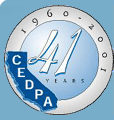

DataBus - Vol 41 No. 2: February-March, 2001
|
Spotlight on Technology: The Environmental and Spatial Technology (EAST) Grant
California has joined in the effort to change the face of technology, one site at a time. What began as one teacher�s idea to assist at-risk students has grown into a grass-roots effort that now encompasses over 150 schools in six states. This month, meetings were held in two California cities for the finalists and semi-finalists of the competitive Environmental and Spatial Technology (EAST) grant. Grant finalists will receive a total award of $125,000 per year for at least two years to implement this grade 9-12 project. Both the ten finalist sites and the six semi-finalist sites received sufficient funding to attend the pre-implementation workshops in California and to also attend the EAST conference in Little Rock, Arkansas on February 19-21, 2001. The EAST model is a dynamic, performance-based learning environment for students utilizing project-based service learning, integrated with advanced technological applications. The setting for this model is an interdisciplinary laboratory environment where the intellectual and problem-solving growth of students, rather than technology, is the focus. Technology is a tool integrated into the learning process; it is not taught as a separate entity. Students learn in a non-traditional environment that may include being out of the classroom and or lab to gather information and do research on a regular basis. Soft skill sets such as effective communication, collaboration, problem-solving and teamwork are nurtured. As part of the hardware and software package for EAST, sites will receive advanced technology workstations, printers, a plotter, and other peripherals. Software will include technical applications from architecture, animation, database development, 3D design engineering, digital imagery, electrical design, global positioning, geographical information systems, image analysis, publishing, visualization and web development. As with any comprehensive program, a key feature of EAST is the staff development component for the teacher/facilitator. EAST provides up to 23 days of training in the first year of implementation. This past week, I felt fortunate to travel with a group from the national EAST project and give pre-implementation workshops in San Diego and Redwood City. I watched closely as Arkansas students enrolled in the EAST program confidently presented their technology projects to a group of approximately 50 California superintendents, principals, teachers, counselors and technology coordinators. Presentations were varied and included assisting firefighters locate fresh water sources for extinguishing brush fires in Hawaii, designing and painting a mural to brighten a county health facility, building a Newtonian telescope and locating suitable areas for a helicopter landing pad to rescue fallen hikers. Even though the projects were inspiring, the EAST directors made it clear to the audience that student projects were focused on the process, rather than the product. EAST has generated a lot of interest and excitement among educators who have seen how the project positively impacts students. California�s first round of competition funded ten demonstration sites throughout the state. A second competition round is planned to fund even more sites. Information about the grant may be obtained from the California Department of Education�s web site: www.cde.ca.gov/east. Student Technology Showcase The California Department of Education will sponsor the first statewide Student Technology Showcase to highlight curriculum-based student technology projects from grades 4-12. Students will have the opportunity to present their projects to an audience that will include parents, teachers, administrators, higher education representatives, California Department of Education employees, California Technology Assistance Project members and legislators or their representatives. The Student Technology Showcase will feature exemplary student projects that may include, but not be limited to, web video, multimedia, graphic art, sensor/probe data and analysis, animation, or database development. This will be an excellent staff development opportunity for teachers and others to see effective integration of technology and the curriculum throughout the state. The event will be held on March 5, 2001, in Sacramento and admission is free. See http://www.cde.ca.gov/showcase/ for more information and registration.
Dr. Joyce Hinkson is a consultant for the California Department of Education's Education Technology Office. She may be reached at (916) 323-2241 or by e-mail at
|
CEDPA